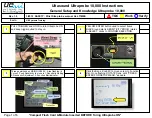
Tel: 886.909 602 109 Email: [email protected]
193
b)
Mirror frequency and multiple responses
During frequency mixing, two input signals can generate the same IF signal with that of the LO signal
with the same frequency, with one signal frequency one IF lower than the LO and another signal
frequency one IF higher than the LO. In this case, one of the signal is called the mirror frequency of the
other. Each frequency of the LO has a mirror frequency of corresponding input signal, with the difference
of two IFs between the signal and the mirror frequency.
Multiple responses refer to two or multiple responses caused by the input signal with signal frequency on
the display, that is, to respond to two or multiple LO frequencies, the interval between the LO
frequencies of such multiple responses is two times of the IF. Multiple responses occur only when the
mixing mode overlaps and LO sweeps a sufficient range to make the input signal mixed in more than one
mode. Since different microwave analyzer has different principle structure, the frequency of mirror and
multiple responses is different.
c)
Residual response
Refers to the discrete response observed on the display when the microwave analyzer is not input with
any signal.
FFT
Abbreviation for Fast Fourier Transform. It performs a specific mathematical analysis of the time domain
signal and gives the results of the frequency domain analysis.
Resolution
Resolution is used to represent the capability of the microwave analyzer to clearly separate two input
signals. It is subject to the influence of some factors such as IF filter bandwidth, rectangle coefficient,
local-oscillator residual frequency modulation, phase noise and sweep time. Most microwave analyzers
can be used to test different resolution bandwidths by using the LC filter, crystal filter, active power filter,
digital filter etc.
Amplitude accuracy
A parameter associated with the amplitude measurement result that characterizes the dispersion of the
amplitude measurement value. Factors affecting amplitude measurement accuracy include frequency
response, scale fidelity, input attenuator conversion error, IF gain, scale factor and resolution bandwidth.
Negative peak detection
A display detection method for signal energy, each displayed point corresponds to a plurality of detected
sample data points of a video signal in a portion of a frequency span or time interval represented by the
point, and the method for extracting the minimum of the data points is called negative peak detection.
Trace
A trace consists of a series of data points containing frequency (time) and amplitude information, which
are usually treated as a set. Traces 1, 2, and 3 are the trace names often used by microwave analyzers.
Intermodulation
If two or more signals are simultaneously loaded at the input of an active device (such as an amplifier or
a mixer), multiple sum frequency and/or difference frequency component of each signal itself produces
intermodulation products due to the nonlinearity of the active device and the harmonics of the generated
signal,. For hand-held microwave spectrum analyzers, these intermodulation products are interference
signals, the lower the level, the better the result. The relationship between the level of the
intermodulation product and level of the input signal is: if the amplitude of the two sinusoidal input signals
varies by ∆ dB, the corresponding intermodulation product level will vary by n ·∆ dB, where n is the order
of the intermodulation product, and represents the sum of the sub-items of the contained frequencies,
such as the frequency 2·f1 +1·f2, and the order is 2+1=3. The intersection point when the amplitude of
the signal and intermodulation product is equal is usually called the intercept point. In fact, this point
does not exist because the output of the active device is compressed when the input signal is amplified
to a certain extent. The intercept point can be defined by the input level or output level, so the nominal
intercept point has an input and output intercept point, which refers to the input intercept point unless
otherwise specified. The intercept point is usually expressed in dBm. The larger the intercept point, the
better the linearity of the microwave analyzer, which is a prerequisite for obtaining a large dynamic range.
In most cases, among the intermodulation products, the second-order products and the third-order






































